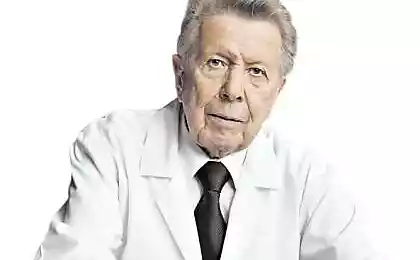2659
13 most "terrible" parasites of the planet (15 photos)
Today we talk about the parasites that cause many feelings of disgust and even fear. Parasitic organisms are found in virtually every living organism, including us.
Most of them can hardly be called parasites in pure form, as a definite benefit in the co-existence and gets "infected" boss. Parasitic organisms are indispensable in our biosphere. They play a significant role in the co-evolution of the majority of species of living organisms, as well as contribute to more efficient energy use in the food chain.
I specifically first place the picture mutant, with the most famous parasite Half - hedkrabeee you to think again about whether you watch the plate.
Images continue to very brutal and impressionable, pregnant, nursing, and people with weak vestibular system, and dining - it is better not to look

Sacculina (Sacculina carcini) sea parasitic crustaceans. The larva is attached to the underside of the abdomen of a crab, "stalk" the parasite penetrates the tissues of crab and branches, "sucking the juice," disrupting the processes of molting and causing parasitic castration of males crab that entails hormonal changes. Hormonal changes cause the appearance in the male crab behavioral characteristic of females. The male crabs begin taking care of the eggs of the parasite, as his "blood offspring»
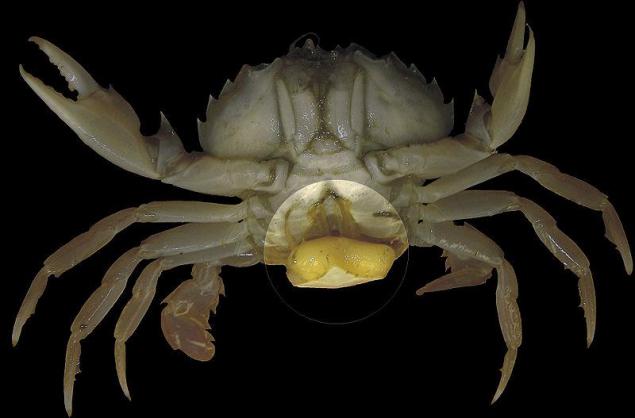
Leykohloridy paradoxical (Leucochloridium paradoxum) is another amazing parasite belonging to a type of flatworm. Definitive host of this parasite are birds. Parasites in the gut. Multiply Leykohloridy follows. Along with the dung of parasite eggs are in an environment that swallows snail Succinea. From eggs develop into larvae and then sporocysts. Outgrowths sporocyst tentacles reaches the cochlea and increases in size, is bright green. For growth spots appear, and he begins to twitch. As a result, the tentacle snail like a caterpillar becomes a butterfly. A bird can not fly by such delicacy, pecks and infected by the parasite. The cycle of the parasite is repeated again.
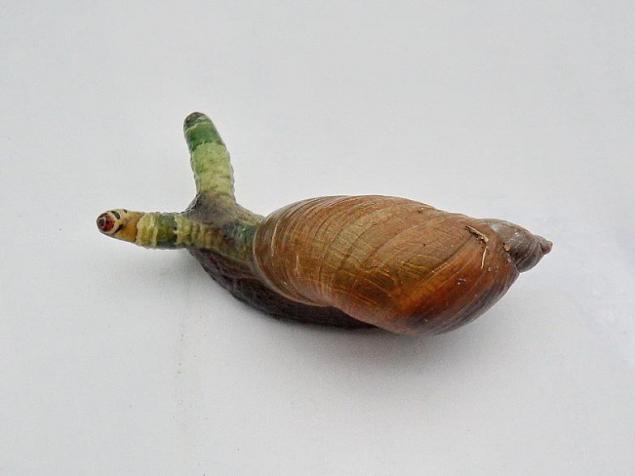
Candiru or catfish Vandelli (Vandellia cirrhosa) swims in the gills of larger fish found in the waters of the Amazon River, rastopyrivat outgrowths that damage tissue gills. Catfish feeds on the blood trickling from the damaged tissues of fish. Candiru identify potential victims on the content of ammonia in water, the selection of which occurs in the process of respiration of fish. For this reason, the locals tend not to celebrate small need in the waters of the Amazon River. In view of the small size of catfish easily penetrates urachus into the bladder. Attaching Candiru to the walls of the bladder is accompanied by severe pain and may cause serious tissue damage, or death. Removal of catfish from the bladder is made by means of surgical intervention (self Candiru leave the bladder can not).
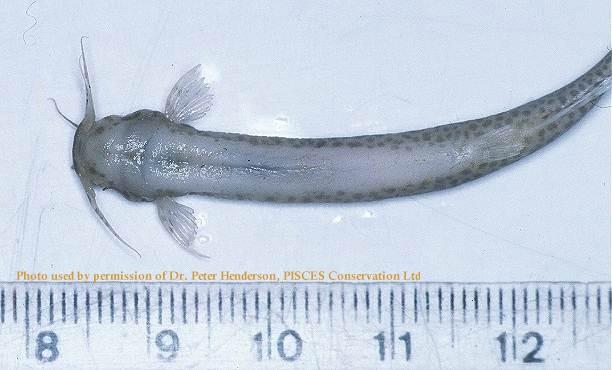
Ticks (genus: Ixodes) have an amazing ability to grow in size, absorbing the amount of blood that is several times more than their own weight. Also ticks are carriers of dangerous diseases such as tick-borne encephalitis and Lyme borreliosis.
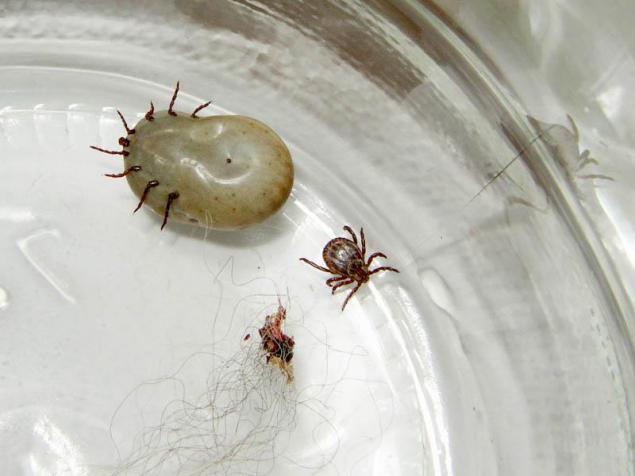
Ovodova (Gasterophilidae) lay larvae under the skin of mammals, including humans. In Central and South America inhabited by human skin gadfly, which lays its eggs on mosquitoes. When the mosquito sits on the covers of the human body, the larvae skin gadfly "vburavlivayutsya" in the skin. Since the bloodstream, they can travel throughout the body, and even to penetrate into the brain through the blood-brain barrier. Eating away the vital parts of the brain, gadfly larvae can lead to death.
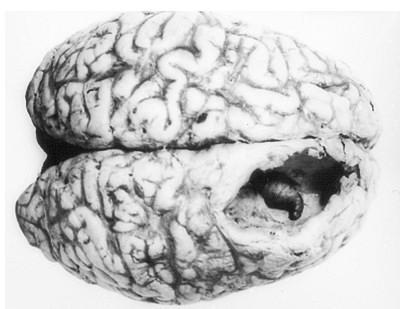
Filaria (Filariidae) - is a parasitic organism, which is also distributed by blood-sucking insects. Getting in the human body the parasite clogs the lymphatics. Violation of lymph flow leads to a widening of the monstrous limbs. That is why the disease caused by these organisms, also called elephantiasis.
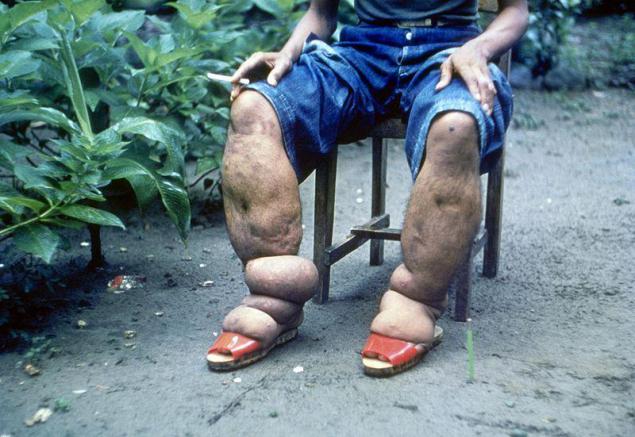
Anisakids - representatives of different genera of Anisakidae, which infest the intestinal tract of many animals, including humans. A person infected with these parasites in the use of fish raw. The popularity of Japanese sushi in Russia has led to the increase of cases anizakidozom. Once in the gastrointestinal tract of a human head portion anisakids introduced into the mucosa in the whole of its length from the pharynx to the large intestine, in severe cases, causing inflammation and necrosis. In developed countries, in the flesh anisakids rid freeze. According to sanitary regulations before eating raw fish should be kept at -20 ° C for at least 5 days.
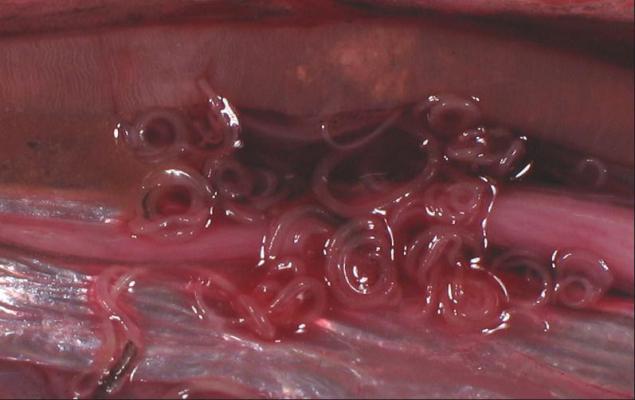
Broad tapeworm (Diphyllobothrium latum) class of parasitic flatworms (Platyhelmithes) - a parasite that can "catch" in the use of poorly cooked or fried river fish. The first intermediate hosts of this parasite are copepods (Cyclops, diaptomus). Second intermediate host, usually becomes a predatory fish (pike, burbot, perch ...). The ultimate owner of a result of eating contaminated fish are carnivorous mammals (cat, dog) and people. In the human intestine tapeworm can reach 20 meters in length and live 29 years if no action is taken. In the night tapeworm produces more than 2 million eggs, which together with the faeces are in the environment.
The class of parasitic flatworms (Platyhelmithes) and are dangerous parasites such as bovine tapeworm, pork tapeworm, sheep mozgovik, echinococcus. These parasites form in various tissues (muscle, liver, brain) oncospheres organisms which can reach large sizes.
Representatives of the above flat parasitic worms are the most dangerous echinococcus, which forms in the liver or other organs of the intermediate host (cow, sheep, pig, man), Finn (bubble increases in size), which can reach large size and lead to death of the organism. Infection occurs when the definitive host eating the meat of an animal killed by echinococcosis. Mozgovik sheep even more dangerous disease. Final hosts of this parasite are predatory mammals (wolves, foxes). Eggs with faeces into the environment, and then in the body of intermediate hosts (sheep people). Penetrating the wall of intestinal parasite enters the bloodstream and then with the blood flow in the brain is. Mozgovik sheep's destroys brain cells, causing the death of the organism. Predator (wolf, fox) eats dead animals and the cycle of the parasite is repeated again.
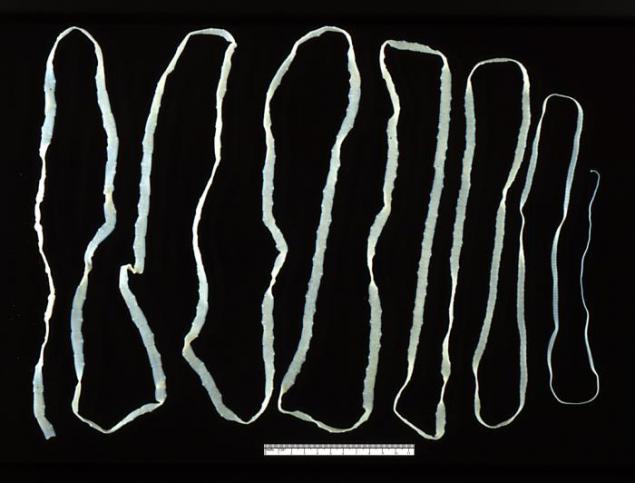
Schistosome (Schistosoma) another group of dangerous parasites that live mainly in tropical countries. The intermediate hosts are molluscs, final - mammals. In humans, the parasite gets when bathing in freshwater ponds directly through the skin. Once in the bloodstream, the larva is in the liver, bladder and cause serious damage. Infection occurs in almost 100% of cases, you just walk barefoot on the body of water, so in some countries, the level of infestation schistosomes close to 100%.

Guinea worm (Dracunculus medinensis) one more unpleasant parasite, living in tropical and subtropical regions of Asia and Africa. Infection with the human representative of this type of roundworms occur by drinking dirty water. Parasite perforate the intestinal wall and is in the lymph vessels, and then in the body cavity. There worms reach sexual maturity. After mating, the males die and the females move into the subcutaneous layer of fat. Breakthrough skin, they stick out the front end of the body and released into the environment a lot of larvae. Intense itching and pain in the legs forcing people to go into the water to relieve their suffering. Parasites that's what you need. Larvae are Cyclops in crustaceans, which again fall within the gastrointestinal tract of a human untreated drinking water. Get rid of the parasite slowly winding it on a match.
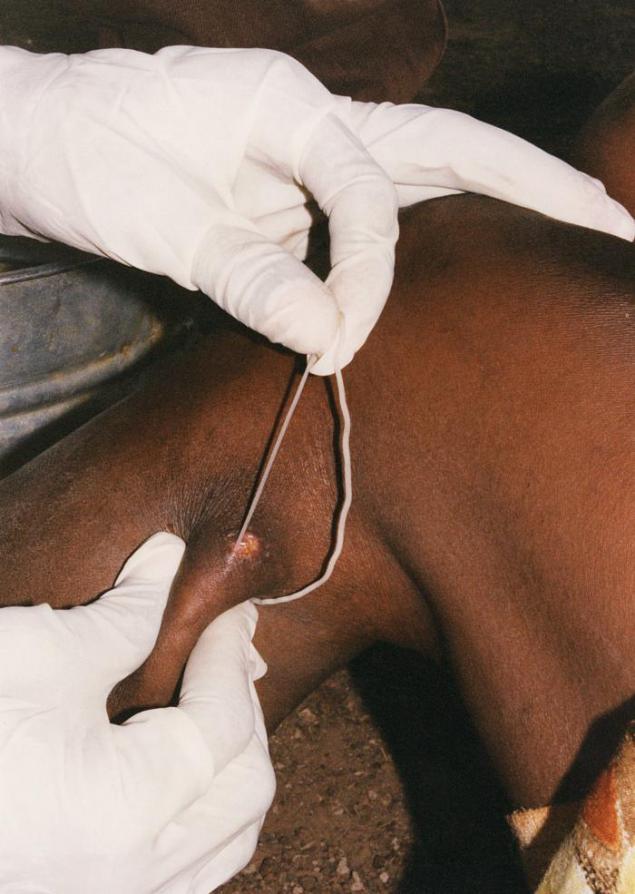
Amoebic meningoencephalitis (Acanthamoeba keratitis) causes damage to the eyeball. Fortunately, the incidence in the world of this parasitic disease is low (1 500 thousand. In the USA), but recently there has been a tendency to its growth. The reason - the increase in the number of people using contact lenses. These parasitic amoeba found in water (lakes, rivers) and moist soil. Once in the eye, these parasites begin to multiply rapidly, causing damage to the eyeball, which can eventually lead to blindness.
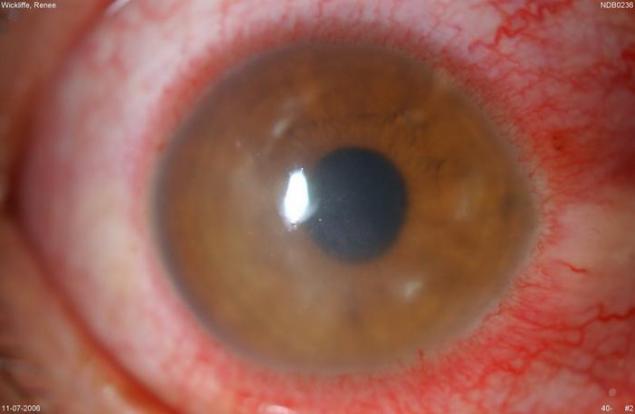
Toxoplasma gondii (Toxoplasma gondii) is another interesting parasite. The main host of this organism are the cat, it takes them a part of the sexual life cycle of the parasite. Asexual cycle portion may extend in the body of other animals (mice, rats, birds), including man. In humans, toxoplasmosis occurs in the form of light (flu-like symptoms), the risk of the parasite is only for pregnant women. This parasite is interesting because it changes the behavior of animals. In particular, rats and mice are no longer afraid of cats and more likely to be eaten. Parasites "profitable" to get out of the infected mouse at a cat body, as it is in the cat runs from Toxoplasma sexual part of the life cycle.
There is evidence that infection with Toxoplasma also has an effect on human behavior. In particular, a person becomes more risky, the reaction slows down, increasing anxiety. Since it has been proven that people infected with Toxoplasma twice as likely to get into car accidents. Toxoplasmosis is a very common disease. In France, Toxoplasma infected, every eighth resident in the UK - one in three, and in the US - one in two!
Many have repeatedly seen on television plots, characters that suit in their apartments "koshatni" from 20-30 or more cats. Studies of some Western scholars suggest that this is also the handiwork of tokspoplazm. These unsanitary conditions contribute to a more rapid spread of the parasite.
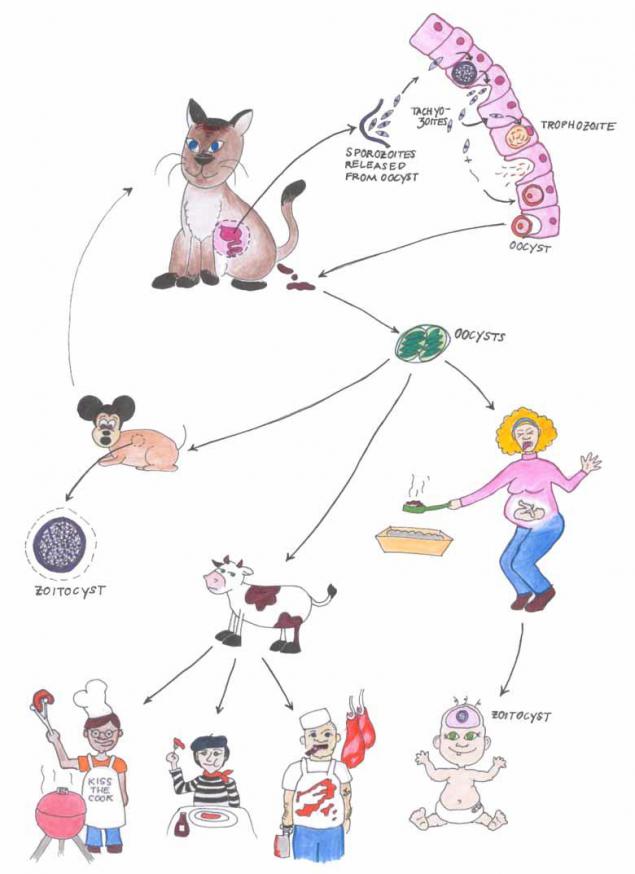
In conclusion, I want to again remind you that the parasitic organisms can hardly be called parasites in its purest form. Each plays an important role in the functioning of the biosphere. In addition, many of the parasites, engaging in a kind of symbiotic relationship with the host, repay him good.
For example, the total destruction of bed bugs after the revolution caused an increase in the number of heart attacks and strokes. Bug in the bite injects a substance that slows down blood clotting, which prevents the formation of blood clots.

It is now scientifically proven that people infected with helminths (worms) do not suffer from a variety of allergic reactions. So recently spent by Western scientists in Viet Nam medical study of schoolchildren in 1500, showed that 2/3 of children infected with nematodes and other intestinal parasites, but any manifestations of allergic reactions among Vietnamese students are very rare.
Mankind has surrounded himself with numerous hygiene products and medicines that instantly destroy the alien body, which happened in our internal environment. Life in these "sterile" conditions went sideways for a man. In the absence of enemies of the human immune system is no longer receiving "shake" and became increasingly "rebel" against its own cells and tissues of the body, appearing in a variety of allergic reactions and other serious diseases (asthma, pancreatitis, multiple sclerosis, etc.). < br /> Already, scientists have successfully struggling with severe manifestations of allergic reactions that lead a person to disability and even death, infecting their patients worms. As a result of a long coevolution of parasites and human parasitic organisms learned to blunt the immune response in order to survive in the host.
To the west is being actively used in the treatment of severe allergies and other diseases related to the disruption of the immune system of worms, such as hookworm and Whipworm. For many patients, the coexistence in symbiosis with these parasites is the only possible way, to live in this world.
It is possible that in the future our pharmacies will products containing in its composition eggs farmed "species" of worms that will deliver us from many diseases.
via priroda.su

Source:
Most of them can hardly be called parasites in pure form, as a definite benefit in the co-existence and gets "infected" boss. Parasitic organisms are indispensable in our biosphere. They play a significant role in the co-evolution of the majority of species of living organisms, as well as contribute to more efficient energy use in the food chain.
I specifically first place the picture mutant, with the most famous parasite Half - hedkrabeee you to think again about whether you watch the plate.
Images continue to very brutal and impressionable, pregnant, nursing, and people with weak vestibular system, and dining - it is better not to look

Sacculina (Sacculina carcini) sea parasitic crustaceans. The larva is attached to the underside of the abdomen of a crab, "stalk" the parasite penetrates the tissues of crab and branches, "sucking the juice," disrupting the processes of molting and causing parasitic castration of males crab that entails hormonal changes. Hormonal changes cause the appearance in the male crab behavioral characteristic of females. The male crabs begin taking care of the eggs of the parasite, as his "blood offspring»

Leykohloridy paradoxical (Leucochloridium paradoxum) is another amazing parasite belonging to a type of flatworm. Definitive host of this parasite are birds. Parasites in the gut. Multiply Leykohloridy follows. Along with the dung of parasite eggs are in an environment that swallows snail Succinea. From eggs develop into larvae and then sporocysts. Outgrowths sporocyst tentacles reaches the cochlea and increases in size, is bright green. For growth spots appear, and he begins to twitch. As a result, the tentacle snail like a caterpillar becomes a butterfly. A bird can not fly by such delicacy, pecks and infected by the parasite. The cycle of the parasite is repeated again.

Candiru or catfish Vandelli (Vandellia cirrhosa) swims in the gills of larger fish found in the waters of the Amazon River, rastopyrivat outgrowths that damage tissue gills. Catfish feeds on the blood trickling from the damaged tissues of fish. Candiru identify potential victims on the content of ammonia in water, the selection of which occurs in the process of respiration of fish. For this reason, the locals tend not to celebrate small need in the waters of the Amazon River. In view of the small size of catfish easily penetrates urachus into the bladder. Attaching Candiru to the walls of the bladder is accompanied by severe pain and may cause serious tissue damage, or death. Removal of catfish from the bladder is made by means of surgical intervention (self Candiru leave the bladder can not).

Ticks (genus: Ixodes) have an amazing ability to grow in size, absorbing the amount of blood that is several times more than their own weight. Also ticks are carriers of dangerous diseases such as tick-borne encephalitis and Lyme borreliosis.

Ovodova (Gasterophilidae) lay larvae under the skin of mammals, including humans. In Central and South America inhabited by human skin gadfly, which lays its eggs on mosquitoes. When the mosquito sits on the covers of the human body, the larvae skin gadfly "vburavlivayutsya" in the skin. Since the bloodstream, they can travel throughout the body, and even to penetrate into the brain through the blood-brain barrier. Eating away the vital parts of the brain, gadfly larvae can lead to death.

Filaria (Filariidae) - is a parasitic organism, which is also distributed by blood-sucking insects. Getting in the human body the parasite clogs the lymphatics. Violation of lymph flow leads to a widening of the monstrous limbs. That is why the disease caused by these organisms, also called elephantiasis.

Anisakids - representatives of different genera of Anisakidae, which infest the intestinal tract of many animals, including humans. A person infected with these parasites in the use of fish raw. The popularity of Japanese sushi in Russia has led to the increase of cases anizakidozom. Once in the gastrointestinal tract of a human head portion anisakids introduced into the mucosa in the whole of its length from the pharynx to the large intestine, in severe cases, causing inflammation and necrosis. In developed countries, in the flesh anisakids rid freeze. According to sanitary regulations before eating raw fish should be kept at -20 ° C for at least 5 days.

Broad tapeworm (Diphyllobothrium latum) class of parasitic flatworms (Platyhelmithes) - a parasite that can "catch" in the use of poorly cooked or fried river fish. The first intermediate hosts of this parasite are copepods (Cyclops, diaptomus). Second intermediate host, usually becomes a predatory fish (pike, burbot, perch ...). The ultimate owner of a result of eating contaminated fish are carnivorous mammals (cat, dog) and people. In the human intestine tapeworm can reach 20 meters in length and live 29 years if no action is taken. In the night tapeworm produces more than 2 million eggs, which together with the faeces are in the environment.
The class of parasitic flatworms (Platyhelmithes) and are dangerous parasites such as bovine tapeworm, pork tapeworm, sheep mozgovik, echinococcus. These parasites form in various tissues (muscle, liver, brain) oncospheres organisms which can reach large sizes.
Representatives of the above flat parasitic worms are the most dangerous echinococcus, which forms in the liver or other organs of the intermediate host (cow, sheep, pig, man), Finn (bubble increases in size), which can reach large size and lead to death of the organism. Infection occurs when the definitive host eating the meat of an animal killed by echinococcosis. Mozgovik sheep even more dangerous disease. Final hosts of this parasite are predatory mammals (wolves, foxes). Eggs with faeces into the environment, and then in the body of intermediate hosts (sheep people). Penetrating the wall of intestinal parasite enters the bloodstream and then with the blood flow in the brain is. Mozgovik sheep's destroys brain cells, causing the death of the organism. Predator (wolf, fox) eats dead animals and the cycle of the parasite is repeated again.

Schistosome (Schistosoma) another group of dangerous parasites that live mainly in tropical countries. The intermediate hosts are molluscs, final - mammals. In humans, the parasite gets when bathing in freshwater ponds directly through the skin. Once in the bloodstream, the larva is in the liver, bladder and cause serious damage. Infection occurs in almost 100% of cases, you just walk barefoot on the body of water, so in some countries, the level of infestation schistosomes close to 100%.

Guinea worm (Dracunculus medinensis) one more unpleasant parasite, living in tropical and subtropical regions of Asia and Africa. Infection with the human representative of this type of roundworms occur by drinking dirty water. Parasite perforate the intestinal wall and is in the lymph vessels, and then in the body cavity. There worms reach sexual maturity. After mating, the males die and the females move into the subcutaneous layer of fat. Breakthrough skin, they stick out the front end of the body and released into the environment a lot of larvae. Intense itching and pain in the legs forcing people to go into the water to relieve their suffering. Parasites that's what you need. Larvae are Cyclops in crustaceans, which again fall within the gastrointestinal tract of a human untreated drinking water. Get rid of the parasite slowly winding it on a match.

Amoebic meningoencephalitis (Acanthamoeba keratitis) causes damage to the eyeball. Fortunately, the incidence in the world of this parasitic disease is low (1 500 thousand. In the USA), but recently there has been a tendency to its growth. The reason - the increase in the number of people using contact lenses. These parasitic amoeba found in water (lakes, rivers) and moist soil. Once in the eye, these parasites begin to multiply rapidly, causing damage to the eyeball, which can eventually lead to blindness.

Toxoplasma gondii (Toxoplasma gondii) is another interesting parasite. The main host of this organism are the cat, it takes them a part of the sexual life cycle of the parasite. Asexual cycle portion may extend in the body of other animals (mice, rats, birds), including man. In humans, toxoplasmosis occurs in the form of light (flu-like symptoms), the risk of the parasite is only for pregnant women. This parasite is interesting because it changes the behavior of animals. In particular, rats and mice are no longer afraid of cats and more likely to be eaten. Parasites "profitable" to get out of the infected mouse at a cat body, as it is in the cat runs from Toxoplasma sexual part of the life cycle.
There is evidence that infection with Toxoplasma also has an effect on human behavior. In particular, a person becomes more risky, the reaction slows down, increasing anxiety. Since it has been proven that people infected with Toxoplasma twice as likely to get into car accidents. Toxoplasmosis is a very common disease. In France, Toxoplasma infected, every eighth resident in the UK - one in three, and in the US - one in two!
Many have repeatedly seen on television plots, characters that suit in their apartments "koshatni" from 20-30 or more cats. Studies of some Western scholars suggest that this is also the handiwork of tokspoplazm. These unsanitary conditions contribute to a more rapid spread of the parasite.

In conclusion, I want to again remind you that the parasitic organisms can hardly be called parasites in its purest form. Each plays an important role in the functioning of the biosphere. In addition, many of the parasites, engaging in a kind of symbiotic relationship with the host, repay him good.
For example, the total destruction of bed bugs after the revolution caused an increase in the number of heart attacks and strokes. Bug in the bite injects a substance that slows down blood clotting, which prevents the formation of blood clots.

It is now scientifically proven that people infected with helminths (worms) do not suffer from a variety of allergic reactions. So recently spent by Western scientists in Viet Nam medical study of schoolchildren in 1500, showed that 2/3 of children infected with nematodes and other intestinal parasites, but any manifestations of allergic reactions among Vietnamese students are very rare.
Mankind has surrounded himself with numerous hygiene products and medicines that instantly destroy the alien body, which happened in our internal environment. Life in these "sterile" conditions went sideways for a man. In the absence of enemies of the human immune system is no longer receiving "shake" and became increasingly "rebel" against its own cells and tissues of the body, appearing in a variety of allergic reactions and other serious diseases (asthma, pancreatitis, multiple sclerosis, etc.). < br /> Already, scientists have successfully struggling with severe manifestations of allergic reactions that lead a person to disability and even death, infecting their patients worms. As a result of a long coevolution of parasites and human parasitic organisms learned to blunt the immune response in order to survive in the host.
To the west is being actively used in the treatment of severe allergies and other diseases related to the disruption of the immune system of worms, such as hookworm and Whipworm. For many patients, the coexistence in symbiosis with these parasites is the only possible way, to live in this world.
It is possible that in the future our pharmacies will products containing in its composition eggs farmed "species" of worms that will deliver us from many diseases.
via priroda.su

Source:















